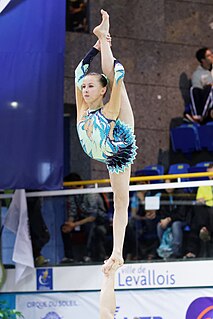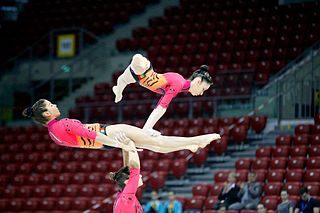
Gymnastics is a sport that includes physical exercises requiring balance, strength, flexibility, agility, coordination, and endurance. The movements involved in gymnastics contribute to the development of the arms, legs, shoulders, back, chest, and abdominal muscle groups. Alertness, precision, daring, self-confidence, and self-discipline are mental traits that can also be developed through gymnastics evolved from exercises used by the ancient Greeks that included skills for mounting and dismounting a horse and from circus performance skills.

Rhythmic gymnastics is a sport in which gymnasts perform on a floor with an apparatus: hoop, ball, clubs, ribbon or rope. The sport combines elements of gymnastics, dance and calisthenics; gymnasts must be strong, flexible, agile, dexterous and coordinated. Rhythmic gymnastics is governed by the International Gymnastics Federation (FIG), which first recognized it as a sport in 1963. It became an Olympic sport in 1984, with an individual all-around event. The group all-around competition was added to the Olympics in 1996. At the international level, rhythmic gymnastics is a women-only sport. The most prestigious competitions, besides the Olympic Games, are the World Championships, World Games, European Championships, European Games, the World Cup Series and the Grand Prix Series. Gymnasts are judged on their artistry, execution of skills, and difficulty of skills, for which they gain points. They perform leaps, balances, pivots, and flexibility movements, along with tossing, catching, rolling and otherwise manipulating the apparatus.
Artistic gymnastics is a discipline of gymnastics in which athletes perform short routines on different apparatuses, with less time for vaulting. The sport is governed by the Fédération Internationale de Gymnastique (FIG), which designs the code of points and regulates all aspects of international elite competition. Within individual countries, gymnastics is regulated by national federations, such as Gymnastics Canada, British Gymnastics, and USA Gymnastics. Artistic gymnastics is a popular spectator sport at many competitions, including the Summer Olympic Games.
At the 2004 Summer Olympics in Athens, Greece, three disciplines of gymnastics were contested: artistic gymnastics, rhythmic gymnastics and trampoline. The artistic gymnastics and trampoline events were held at the Olympic Indoor Hall and the rhythmic gymnastics events were held at the Galatsi Olympic Hall.
These are the results for the women's individual trampoline competition, one of two events of the trampoline discipline contested in the gymnastics at the 2004 Summer Olympics in Athens. The qualification and final rounds took place on August 20 at the Olympic Indoor Hall.
At the 1988 Summer Olympics, two different gymnastics disciplines were contested: artistic gymnastics and rhythmic gymnastics. The artistic gymnastics events were held at the Olympic Gymnastics Hall in Seoul from September 18 through 25th. The rhythmic gymnastics events were held at the same venue from September 28 through 30th.

Acrobatic gymnastics is a competitive gymnastic discipline where partnerships of gymnasts work together and perform figures consisting of acrobatic moves, dance and tumbling, set to music. There are three types of routines; a 'balance' routine where the focus is on strength, poise and flexibility; a 'dynamic' routine which includes throws, somersaults and catches, and a 'combined' routine which includes elements from both balance and dynamic.
Women's rhythmic group all-around competition at the 2008 Summer Olympics was held at the Beijing University of Technology Gymnasium.
Women's rhythmic individual all-around competition at the 2008 Summer Olympics was held at the Beijing University of Technology Gymnasium.
Women's trampoline competition at the 2008 Summer Olympics was held on August 18 at the Beijing National Indoor Stadium.
These are the results of the rhythmic individual all-around competition, the only Rhythmic Gymnastic event at the 1988 Summer Olympics.
These are the results of the rhythmic individual all-around competition, the only Rhythmic Gymnastic event at the 1992 Summer Olympics. The four pieces of apparatus used were ball, clubs, hoop, and rope. 42 gymnasts competed in the preliminary round.

The 2011 World Artistic Gymnastics Championships were held in Tokyo, Japan, from October 7–16, 2011, at the Tokyo Metropolitan Gymnasium. Due to uncertainty over the nuclear situation following the 2011 Tōhoku earthquake and tsunami, the International Federation of Gymnastics revealed it was considering moving the event, but on May 22 FIG president Bruno Grandi announced that the World Championships would take place in Tokyo as planned.
Girl's rhythmic team all-around competition at the 2010 Summer Youth Olympics was held at the Bishan Sports Hall.

The Women's rhythmic individual all-around competition contested at the 2012 Summer Olympics. The event was held at the Wembley Arena on 9–11 August.
The girls' rhythmic individual all-around at the 2014 Summer Youth Olympics was held on August 26–27 at the Nanjing Olympic Sports Centre. There were two rounds of competition in the individual competition. In each round, competing gymnasts performed four routines. One routine was performed with each of the four apparatus: rope, hoop, ball and clubs. The combined scores from the four routines made up the preliminary qualifications round score. The top eight gymnasts after the preliminary round advanced to the finals. There, they performed each routine again. Scores from the preliminary will not be carried over, the gymnasts start back their routines with maximum of D10/E10 in base value.
The girls' rhythmic group all-around at the 2014 Summer Youth Olympics was held on August 26–27 at the Nanjing Olympic Sports Centre.
The Men's artistic individual all-around competition at the 2016 Summer Olympics was held on 10 August 2016 at the HSBC Arena. Kōhei Uchimura won gold, becoming the first male gymnast in 44 years to do this in two successive Olympic Games.
The Men's floor competition at the 2016 Summer Olympics was held at the HSBC Arena on 14 August.
The Women's rhythmic individual all-around competition at the 2016 Summer Olympics was held at the HSBC Arena.




